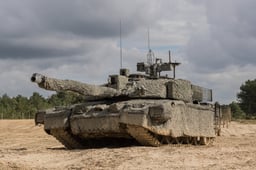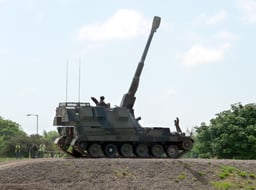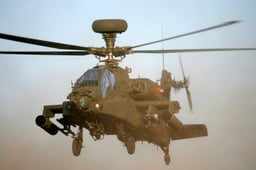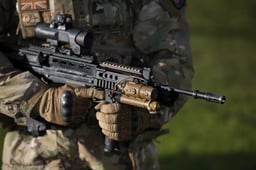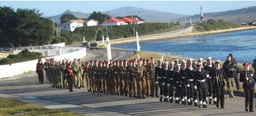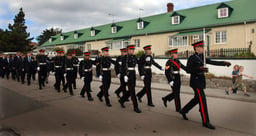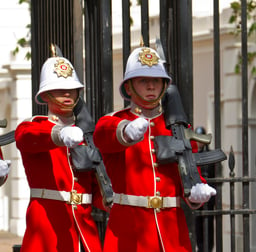British Army
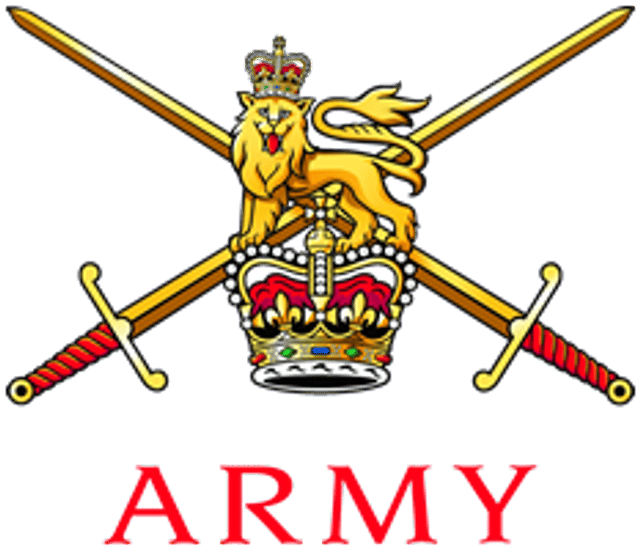
British Army

| British Army | |
|---|---|
| Founded | 1660 (359 years ago)[6][7][1] |
| Country | United Kingdom |
| Type | Army |
| Role | Land warfare |
| Size | 81,500 regulars[2]27,000Army Reserve[3] |
| Part of | British Armed Forces |
| Patron | Elizabeth II |
| Website | www.army.mod.uk[230] |
| Commanders | |
| Chief of the General Staff | GeneralSir Mark Carleton-Smith[9] |
| Deputy Chief of the General Staff | Lieutenant GeneralChristopher Tickell[10] |
| Army Sergeant Major | Warrant Officer Class 1Gavin Paton |
| Insignia | |
| Non-ceremonial flag | |
| Logo | |
The British Army is the principal land warfare force of the United Kingdom, a part of British Armed Forces. As of 2018, the British Army comprises just over 81,500 trained regular (full-time) personnel and just over 27,000 trained reserve (part-time) personnel.[11]
The modern British Army traces back to 1707, with an antecedent in the English Army that was created during the Restoration in 1660. The term British Army was adopted in 1707 after the Acts of Union between England and Scotland.[7][13] Although all members of the British Army are expected to swear (or affirm) allegiance to Elizabeth II as their commander-in-chief,[14] the Bill of Rights of 1689 requires parliamentary consent for the Crown to maintain a peacetime standing army.[15] Therefore, Parliament approves the army by passing an Armed Forces Act at least once every five years. The army is administered by the Ministry of Defence and commanded by the Chief of the General Staff.[16]
The British Army has seen action in major wars between the world's great powers, including the Seven Years' War, the Napoleonic Wars, the Crimean War and the First and Second World Wars. Britain's victories in these decisive wars allowed it to influence world events and establish itself as one of the world's leading military and economic powers.[17][18] Since the end of the Cold War, the British Army has been deployed to a number of conflict zones, often as part of an expeditionary force, a coalition force or part of a United Nations peacekeeping operation.[19]
| British Army | |
|---|---|
| Founded | 1660 (359 years ago)[6][7][1] |
| Country | United Kingdom |
| Type | Army |
| Role | Land warfare |
| Size | 81,500 regulars[2]27,000Army Reserve[3] |
| Part of | British Armed Forces |
| Patron | Elizabeth II |
| Website | www.army.mod.uk[230] |
| Commanders | |
| Chief of the General Staff | GeneralSir Mark Carleton-Smith[9] |
| Deputy Chief of the General Staff | Lieutenant GeneralChristopher Tickell[10] |
| Army Sergeant Major | Warrant Officer Class 1Gavin Paton |
| Insignia | |
| Non-ceremonial flag | |
| Logo | |
History
Formation
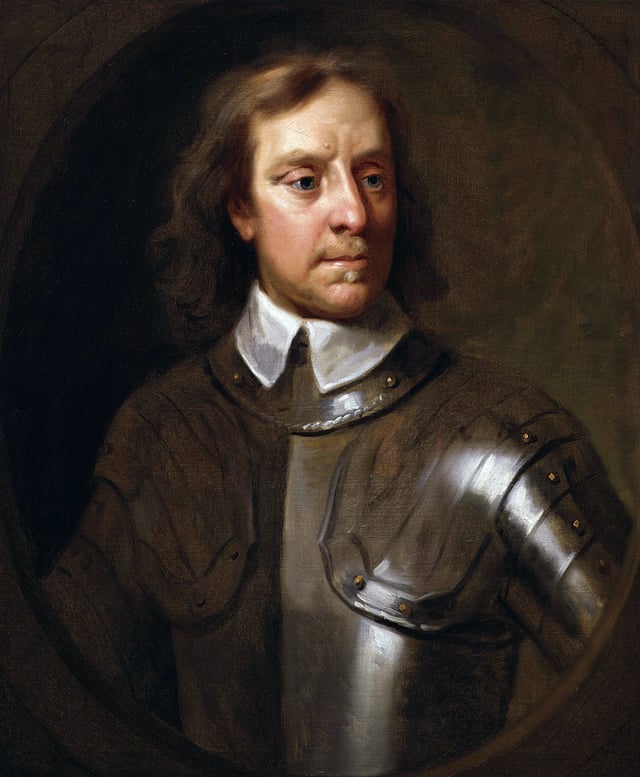
Lord Protector Oliver Cromwell
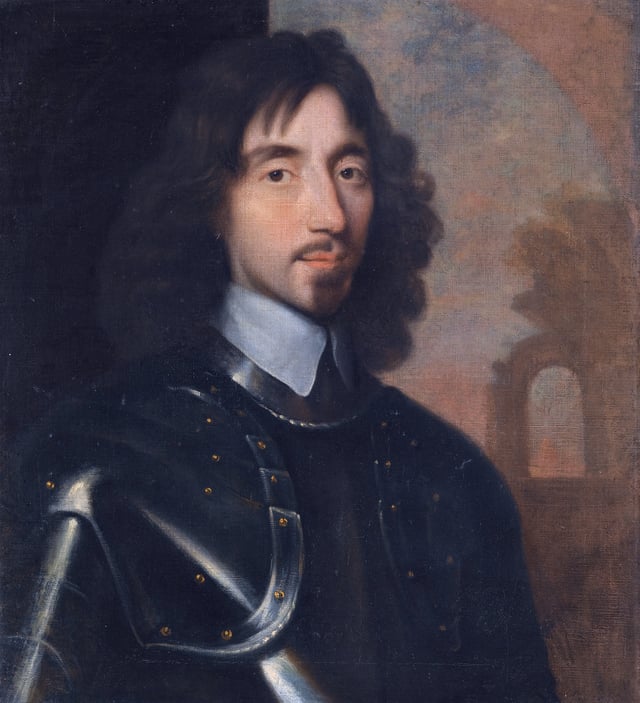
Lord General Thomas Fairfax, the first commander of the New Model Army
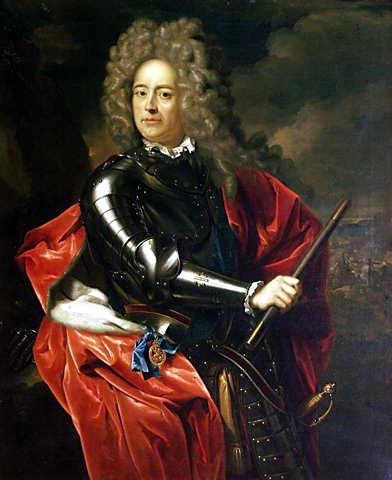
John Churchill, 1st Duke of Marlborough, was one of the first generals in the British Army and fought in the War of the Spanish Succession.
Until the English Civil War, England never had a standing army with professional officers and careerist corporals and sergeants. It relied on militia organized by local officials, or private forces mobilized by the nobility, or on hired mercenaries from Europe.[20] From the later Middle Ages until the English Civil War, when a foreign expeditionary force was needed, such as the one that Henry V of England took to France and that fought at the Battle of Agincourt (1415), the army, a professional one, was raised for the duration of the expedition.[21]
During the English Civil War, the members of the Long Parliament realised that the use of county militia organised into regional associations (such as the Eastern Association), often commanded by local members of parliament (both from the House of Commons and the House of Lords), while more than able to hold their own in the regions which Parliamentarians controlled, were unlikely to win the war. So Parliament initiated two actions. The Self-denying Ordinance, with the notable exception of Oliver Cromwell, forbade members of parliament from serving as officers in the Parliamentary armies. This created a distinction between the civilians in Parliament, who tended to be Presbyterian and conciliatory to the Royalists in nature, and a corps of professional officers, who tended to Independent (Congregational) in theology, to whom they reported. The second action was legislation for the creation of a Parliamentary-funded army, commanded by Lord General Thomas Fairfax, which became known as the New Model Army (originally new-modelled Army).[22]
While this proved to be a war winning formula, the New Model Army, being organized and politically active, went on to dominate the politics of the Interregnum and by 1660 was widely disliked. The New Model Army was paid off and disbanded at the Restoration of the monarchy in 1660. For many decades the alleged excesses of the New Model Army under the Protectorate of Oliver Cromwell were used as propaganda (and still feature in Irish folklore) and the Whig element recoiled from allowing a standing army.[23] The militia acts of 1661 and 1662 prevented local authorities from calling up militia and oppressing their own local opponents. Calling up the militia was possible only if the king and local elites agreed to do so.[24]
Charles II and his Cavalier supporters favoured a new army under royal control; and immediately after the Restoration began working on its establishment.[25] The first English Army regiments, including elements of the disbanded New Model Army, were formed between November 1660 and January 1661[26] and became a standing military force for England (financed by Parliament).[27][28] The Royal Scots and Irish Armies were financed by the parliaments of Scotland and Ireland.[29] Parliamentary control was established by the Bill of Rights 1689 and Claim of Right Act 1689, although the monarch continued to influence aspects of army administration until at least the end of the nineteenth century.[30]
After the Restoration Charles II pulled together four regiments of infantry and cavalry, calling them his guards, at a cost of £122,000 from his general budget.
This became the foundation of the permanent English Army.
By 1685 it had grown to 7,500 soldiers in marching regiments, and 1,400 men permanently stationed in garrisons.
A rebellion in 1685 allowed James II to raise the forces to 20,000 men. There were 37,000 in 1678, when England played a role in the closing stage of the Franco-Dutch War. After William and Mary's accession to the throne England involved itself in the War of the Grand Alliance, primarily to prevent a French invasion restoring James II (Mary's father).[31] In 1689, William III expanded the army to 74,000, and then to 94,000 in 1694. Parliament was very nervous, and reduced the cadre to 7000 in 1697. Scotland and Ireland had theoretically separate military establishments, but they were unofficially merged with the English force.[32]The%20Oxford%20history%20of%20the%20British%20]][[33]](https://openlibrary.org/search?q=Correlli%20Barnett%2C%20 [[CITE|33|https://openlibrary.org/search?q=Correlli%20Barnett%2C%20*Britain%20and%20her%20army%2C%201509%E2%80%931970)
By the time of the 1707 Acts of Union, many regiments of the English and Scottish armies were combined under one operational command and stationed in the Netherlands for the War of the Spanish Succession. Although all the regiments were now part of the new British military establishment,[8] they remained under the old operational-command structure and retained much of the institutional ethos, customs and traditions of the standing armies created shortly after the restoration of the monarchy 47 years earlier. The order of seniority of the most-senior British Army line regiments is based on that of the English army. Although technically the Scots Royal Regiment of Foot was raised in 1633 and is the oldest Regiment of the Line,[34] Scottish and Irish regiments were only allowed to take a rank in the English army on the date of their arrival in England (or the date when they were first placed on the English establishment). In 1694, a board of general officers was convened to decide the rank of English, Irish and Scots regiments serving in the Netherlands; the regiment which became known as the Scots Greys were designated the 4th Dragoons because there were three English regiments raised prior to 1688, when the Scots Greys were first placed in the English establishment. In 1713, when a new board of general officers was convened to decide the rank of several regiments, the seniority of the Scots Greys was reassessed and based on their June 1685 entry into England. At that time there was only one English regiment of dragoons, and the Scots Greys eventually received the British Army rank of 2nd Dragoons.[35]
British Empire (1700–1914)
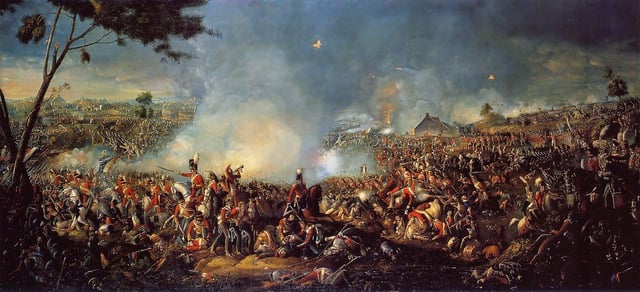
The Duke of Wellington and Field Marshal von Blücher's triumph over Napoleon Bonaparte at the Battle of Waterloo
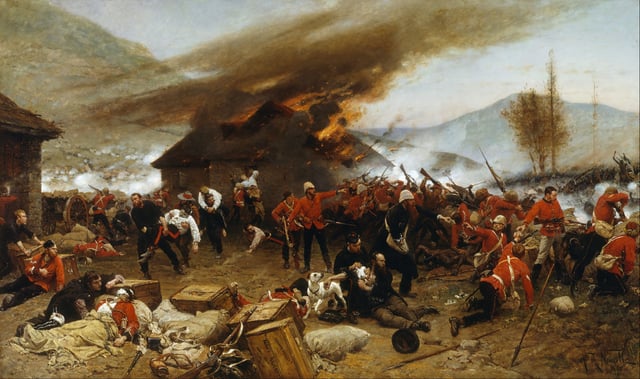
In the 1879 Battle of Rorke's Drift, a small British force repelled an attack by overwhelming Zulu forces; eleven Victoria Crosses were awarded for its defence.
After 1700 British continental policy was to contain expansion by competing powers such as France and Spain.
Although Spain was the dominant global power during the previous two centuries and the chief threat to England's early transatlantic ambitions, its influence was now waning.
The territorial ambitions of the French, however, led to the War of the Spanish Succession[36] and the Napoleonic Wars.[37]
Although the Royal Navy is widely regarded as vital to the rise of the British Empire, the British Army played an important role in the formation of colonies, protectorates and dominions in the Americas, Africa, Asia, India and Australasia.[38] British soldiers captured strategically-important territories, and the army was involved in wars to secure the empire's borders and support friendly governments. Among these actions were the Seven Years' War,[39] the American Revolutionary War,[40] the Napoleonic Wars,[37] the First and Second Opium Wars,[41] the Boxer Rebellion,[42] the New Zealand Wars,[43] the Sepoy Rebellion of 1857,[44] the first and second Boer Wars,[45] the Fenian raids,[46] the Irish War of Independence,[47] interventions in Afghanistan (intended to maintain a buffer state between British India and the Russian Empire)[48] and the Crimean War (to keep the Russian Empire at a safe distance by aiding Turkey).[49] Like the English Army, the British Army fought the kingdoms of Spain, France (including the Empire of France) and the Netherlands for supremacy in North America and the West Indies. With native and provincial assistance, the army conquered New France in the North American theatre of the Seven Years' War[39] and suppressed a Native American uprising in Pontiac's War.[50] The British Army was defeated in the American Revolutionary War, losing the Thirteen Colonies but retaining The Canadas and The Maritimes as British North America.[51]
The British Army was heavily involved in the Napoleonic Wars, participating in a number of campaigns in Europe (including continuous deployment in the Peninsular War), the Caribbean, North Africa and North America. The war between the British and the First French Empire of Napoleon Bonaparte stretched around the world; at its peak in 1813, the regular army contained over 250,000 men. A coalition of Anglo-Dutch and Prussian armies under the Duke of Wellington and Field Marshal von Blücher finally defeated Napoleon at Waterloo in 1815.[52]
The English were involved politically and militarily in Ireland since receiving the Lordship of Ireland from the pope in 1171. The campaign of English republican Protector Oliver Cromwell involved uncompromising treatment of the Irish towns (most notably Drogheda and Wexford) which supported the Royalists during the English Civil War. The English Army (and the subsequent British Army) remained in Ireland primarily to suppress Irish revolts or disorder. In addition to its conflict with Irish nationalists, it was faced with the prospect of battling Anglo-Irish and Ulster Scots in Ireland who were angered by unfavourable taxation of Irish produce imported into Britain. With other Irish groups, they raised a volunteer army and threatened to emulate the American colonists if their conditions were not met. Learning from their experience in America, the British government sought a political solution. The British Army fought Irish rebels—Protestant and Catholic—primarily in Ulster and Leinster (Wolfe Tone's United Irishmen) in the 1798 rebellion.[53]
In addition to battling the armies of other European empires (and its former colonies, the United States, in the War of 1812),[54] the British Army fought the Chinese in the first and second Opium Wars[41] and the Boxer Rebellion,[42] Māori tribes in the first of the New Zealand Wars,[43] Nawab Shiraj-ud-Daula's forces and British East India Company mutineers in the Sepoy Rebellion of 1857,[45] the Boers in the first and second Boer Wars,[45] Irish Fenians in Canada during the Fenian raids[46] and Irish separatists in the Anglo-Irish War.[41] The increasing demands of imperial expansion and the inadequacy and inefficiency of the underfunded British Army, Militia, Yeomanry and Volunteer Force after the Napoleonic Wars led to the late-19th-century Cardwell and Childers Reforms, which gave the army its modern shape and redefined its regimental system.[55] The 1907 Haldane Reforms created the Territorial Force as the army's volunteer reserve component, merging and reorganising the Volunteer Force, Militia and Yeomanry.[56]
World Wars (1914–1945)

Queen Elizabeth in Auxiliary Territorial Service, April 1945
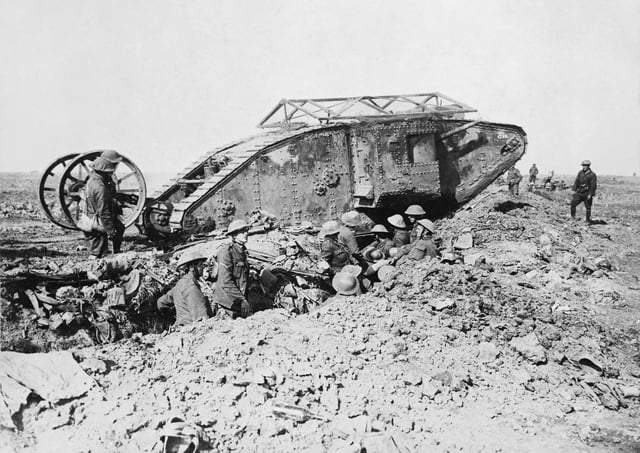
British First World War Mark I tank; the guidance wheels behind the main body were later scrapped as unnecessary. Armoured vehicles of the era required considerable infantry and artillery support. Ernest Brooks)

Infantrymen of the Middlesex Regiment with horse-drawn Lewis gun carts returning from the trenches near Albert, France in September 1916. In the background is a line of supply lorries.
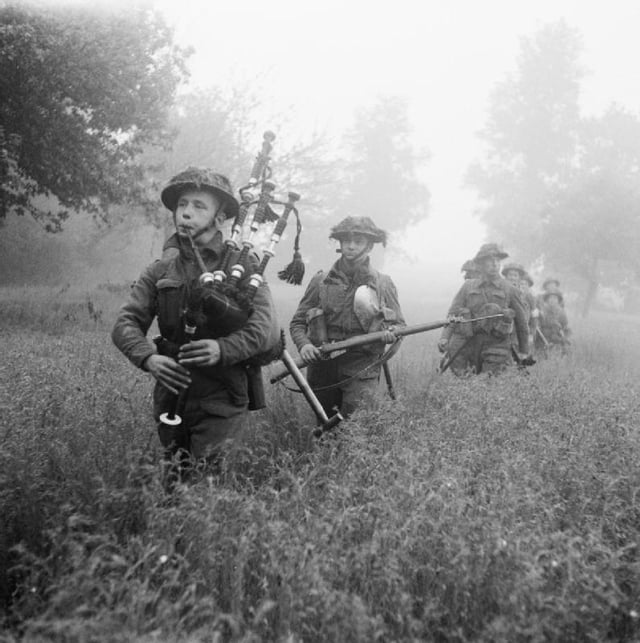
Led by their piper, men of the 7th Battalion, Seaforth Highlanders (part of the 46th (Highland) Brigade), advance during Operation Epsom on 26 June 1944
Great Britain was challenged by other powers, primarily the German Empire and the Third Reich, during the 20th century. A century earlier it vied with Napoleonic France for global pre-eminence, and Hanoverian Britain's natural allies were the kingdoms and principalities of northern Germany. By the middle of the 19th century, Britain and France were allies in preventing Russia's appropriation of the Ottoman Empire, although the fear of French invasion led shortly afterwards to the creation of the Volunteer Force. By the first decade of the 20th century, the United Kingdom was allied with France (by the Entente Cordiale) and Russia (which had a secret agreement with France for mutual support in a war against the Prussian-led German Empire and the Austro-Hungarian Empire).[57]
When the First World War broke out in August 1914 the British Army sent the British Expeditionary Force (BEF), consisting mainly of regular army troops, to France and Belgium.[58] The fighting bogged down into static trench warfare for the remainder of the war. In 1915 the army created the Mediterranean Expeditionary Force to invade the Ottoman Empire via Gallipoli, an unsuccessful attempt to capture Constantinople and secure a sea route to Russia.[59]
The First World War was the most devastating in British military history, with nearly 800,000 men killed and over two million wounded. Early in the war, the BEF was virtually destroyed and was replaced first by volunteers and then by a conscript force. Major battles included those at the Somme and Passchendaele.[60] Advances in technology saw the advent of the tank[61] (and the creation of the Royal Tank Regiment) and advances in aircraft design (and the creation of the Royal Flying Corps) which would be decisive in future battles.[62] Trench warfare dominated Western Front strategy for most of the war, and the use of chemical weapons (disabling and poison gases) added to the devastation.[63]
The Second World War broke out in September 1939 with the Russian and German Army's invasion of Poland.[64] British assurances to the Poles led the British Empire to declare war on Germany. As in the First World War, a relatively small BEF was sent to France[64] but then hastily evacuated from Dunkirk as the German forces swept through the Low Countries and across France in May 1940.[65]
After the British Army recovered from its earlier defeats, it defeated the Germans and Italians at the Second Battle of El Alamein in North Africa in 1942–1943 and helped drive them from Africa. It then fought through Italy[66] and, with the help of American, Canadian, Australian, New Zealand, Indian and Free French forces,[67] and took part in the D-Day invasion of Normandy on 6 June 1944; nearly half the Allied soldiers were British.[68] In the Far East, the British Army rallied against the Japanese in the Burma Campaign and regained the British Far Eastern colonial possessions.[69]
Postcolonial era (1945–2000)
After the Second World War the British Army was significantly reduced in size, although National Service continued until 1960.[70] This period saw decolonisation begin with the partition and independence of India and Pakistan, followed by the independence of British colonies in Africa and Asia. Although the British Army was a major participant in Korea in the early 1950s[70] and Suez in 1956,[71] during this period Britain's role in world events was reduced and the army was downsized.[72] The British Army of the Rhine, consisting of I (BR) Corps, remained in Germany as a bulwark against Soviet invasion.[73] The Cold War continued, with significant technological advances in warfare, and the army saw the introduction of new weapons systems.[74] Despite the decline of the British Empire, the army was engaged in Aden,[75] Indonesia, Cyprus,[75] Kenya[75] and Malaya.[76] In 1982, the British Army and the Royal Marines helped liberate the Falkland Islands during the conflict with Argentina after that country's invasion of the British territory.[77]
In the three decades following 1969, the army was heavily deployed in Northern Ireland's Operation Banner to support the Royal Ulster Constabulary (later the Police Service of Northern Ireland) in their conflict with republican paramilitary groups.[78] The locally recruited Ulster Defence Regiment was formed, becoming home-service battalions of the Royal Irish Regiment in 1992 before it was disbanded in 2006. Over 700 soldiers were killed during the Troubles. Following the 1994–1996 IRA ceasefires and since 1997, demilitarisation has been part of the peace process and the military presence has been reduced.[79] On 25 June 2007 the 2nd Battalion of the Princess of Wales's Royal Regiment left the army complex in Bessbrook, County Armagh, ending the longest operation in British Army history.[80]
Persian Gulf War
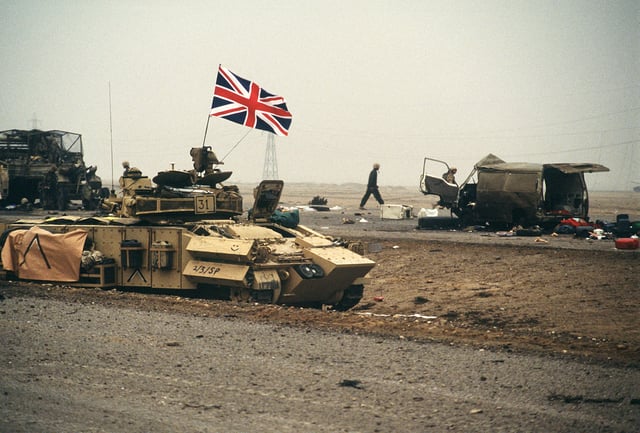
Wrecked and abandoned vehicles along the Highway of Death
The British Army contributed 50,000 troops to the coalition which fought Iraq in the Persian Gulf War,[81] and British forces controlled Kuwait after its liberation. Forty-seven British military personnel died during the war.[82]
Balkan conflicts
The army was deployed to Yugoslavia in 1992. Initially part of the United Nations Protection Force,[83] in 1995 its command was transferred to the Implementation Force (IFOR) and then to the Stabilisation Force in Bosnia and Herzegovina (SFOR);[84] the commitment rose to over 10,000 troops. In 1999, British forces under SFOR command were sent to Kosovo and the contingent increased to 19,000 troops.[85] Between early 1993 and June 2010, 72 British military personnel died during operations in the former Yugoslavian countries of Bosnia, Kosovo and Macedonia.[86]
The Troubles
Although there have been permanent garrisons in Northern Ireland throughout its history, the British Army was deployed as a peacekeeping force from 1969 to 2007 in Operation Banner.[87] Initially, this was (in the wake of unionist attacks on nationalist communities in Derry[88] and Belfast)[89] to prevent further loyalist attacks on Catholic communities; it developed into support of the Royal Ulster Constabulary (RUC) and its successor, the Police Service of Northern Ireland (PSNI) against the Provisional Irish Republican Army (PIRA).[90] Under the 1998 Good Friday Agreement, there was a gradual reduction in the number of soldiers deployed.[91] In 2005, after the PIRA declared a ceasefire, the British Army dismantled posts, withdrew many troops and restored troop levels to those of a peacetime garrison.[92]
Operation Banner ended at midnight on 31 July 2007 after about 38 years of continuous deployment, the longest in British Army history.[93] According to an internal document released in 2007, the British Army had failed to defeat the IRA but made it impossible for them to win by violence.
Operation Helvetic replaced Operation Banner in 2007, maintaining fewer service personnel in a more-benign environment.[93][87] Of the 300,000 troops who served in Northern Ireland since 1969, there were 763 British military personnel killed[95] and 306 killed by the British military, mostly civilians.[96] An estimated 100 soldiers committed suicide during Operation Banner or soon afterwards and a similar number died in accidents. A total of 6,116 were wounded.[97]
Recent history (2000–present)
War in Afghanistan
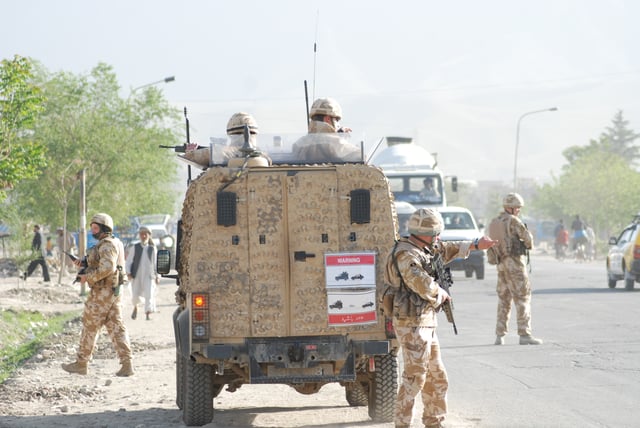
Royal Anglian Regiment in Helmand Province
In November 2001, as part of Operation Enduring Freedom with the United States, the United Kingdom deployed forces in Afghanistan to topple the Taliban in Operation Herrick.[98] The 3rd Division were sent to Kabul to assist in the liberation of the capital and defeat Taliban forces in the mountains. In 2006 the British Army began concentrating on fighting Taliban forces and bringing security to Helmand Province, with around 9,500 British troops (including marines, airmen and sailors) deployed at its peak[99]—the second-largest force after that of the US.[100] In December 2012 Prime Minister David Cameron announced that the combat mission would end in 2014, and troop numbers gradually fell as the Afghan National Army took over the brunt of the fighting. Between 2001 and 26 April 2014 a total of 453 British military personnel died in Afghan operations.[101] Operation Herrick ended with the handover of Camp Bastion on 26 October 2014,[102] but the British Army maintains a deployment in Afghanistan as part of Operation Toral.[103]
Iraq War
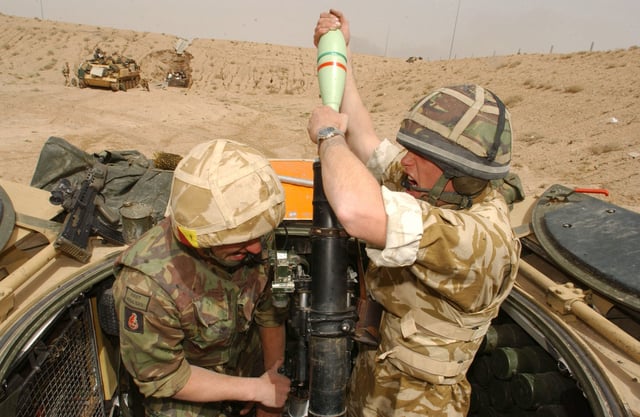
British soldiers from the 1st Battalion, Royal Regiment of Fusiliers battlegroup engage Iraqi positions with an 81mm mortar south of Basra
In 2003 the United Kingdom was a major contributor to the invasion of Iraq, sending a force of over 46,000 military personnel. The British Army controlled southern Iraq, and maintained a peace-keeping presence in Basra.[104] All British troops were withdrawn from Iraq by 30 April 2009, after the Iraqi government refused to extend their mandate.[105] One hundred and seventy-nine British military personnel died in Iraqi operations.[86] The British Armed Forces returned to Iraq in 2014 as part of Operation Shader to counter the Islamic State (ISIL).[106]
UK operations and military aid to the civil authorities
The British Army maintains a standing liability to support the civil authorities in certain circumstances, usually in either niche capabilities (e.g. explosive ordance removal) or in general support of the civil authorities when their capacity is exceeded.[107][108] In recent years this has been seen as army personnel supporting the civil authorities in the face of the 2001 United Kingdom foot-and-mouth outbreak, the 2002 firefighters strike, widespread flooding in 2005, 2007, 2009, 2013 and 2014 and most recently supporting the security services in Operation Temperer following the 2017 Manchester Arena bombing.[109]
Modern army
Personnel
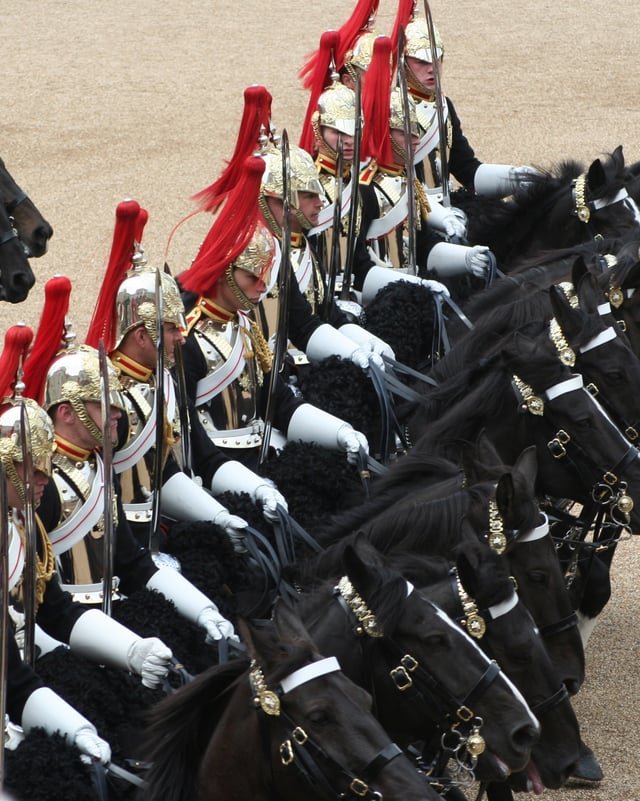
The Blues and Royals Trooping the Colour in 2007
The British Army has been a volunteer force since national service ended during the 1960s.[70] Since the creation of the part-time, reserve Territorial Force in 1908 (renamed the Army Reserve in 2014), the full-time British Army has been known as the Regular Army. In January 2018 there were just over 81,500 trained Regulars and 27,000 Army Reservists.[8]
Following the Strategic Defence and Security Review 2010 (SDSR) and the Strategic Defence and Security Review 2015 the British Army adopted an evolving structure (known as Army 2020 Refine) that would see the number of Regular personnel set at 82,000 and see an increase in the number of Reservists to 30,000. This would bring the ratio of regular to part-time personnel in line with the US and Canada and better integrate the Army Reserve into the Regular Army.[111]
In addition to the active Regular and Reserve force all former Regular Army personnel may be recalled for duty if required (known as the Regular Reserve).[112] The Regular Reserve has two categories: A and D. Category A is mandatory, with the length of time in the category dependent on time spent in Regular Army service. Category D is voluntary, and consists of personnel who are no longer required to serve in category A. Regular Reserves in both categories serve under a fixed-term reserve contract and may report for training or service overseas and at home,[112] similar to the Army Reserve.[113][112] In 2007, there were 121,800 Regular Reserves, of which 33,760 served in categories A and D.[114] Beginning in April 2013, the full Regular Reserve strength was no longer reported—only those serving in categories A and D (30,000 in 2015).[115] The table below illustrates British Army personnel figures from 1710 to 2015.
The Army Reserve (Territorial Army) was established in 1908.
| British Army strength[4] | |||||||||
|---|---|---|---|---|---|---|---|---|---|
| (1707–1800) | (1801–1921) | (1921– Present) | |||||||
| Year | Regular Army | Year | Regular Army | Year | Regular Army | Army Reserve | **Total** | ||
| 1710 | 70,000 | 1810 | 226,000 | 1921 | Interwar period | — | |||
| 1720 | 20,000 | 1820 | 114,000 | 1930 | — | ||||
| 1730 | 20,000 | 1830 | 106,000 | 1945[127] | 3,120,000 | Included in Regular | 3,120,000 | ||
| 1740 | 55,000 | 1840 | 130,000 | 1950 | 364,000 | 83,000 | 447,000 | ||
| 1750 | 27,000 | 1850 | 151,000 | 1960 | 258,000 | 120,000 | 387,000 | ||
| 1760 | 87,000 | 1860 | 215,000 | 1970 | 176,000 | 80,000 | 256,000 | ||
| 1770 | 48,000 | 1870 | 185,000 | 1980 | 159,000 | 63,000 | 222,000 | ||
| 1780 | 79,000 | 1880 | 165,000 | 1990 | 153,000 | 73,000 | 226,000 | ||
| 1790 | 84,000 | 1890 | 210,000 | 2000 | 110,000 | 45,000 | 155,000 | ||
| 1800 | 163,000 | 1900 | 275,000 | 2010 | 113,000 | 29,000 | 142,000 | ||
| 1918[128] | 3,820,000 | 2015 | 83,360 | 29,603 | 112,990 | ||||
Equipment
Infantry
The British Army's basic infantry weapon is the L85A2 or L85A3 assault rifle, sometimes equipped with an L17A2 under-barrel grenade launcher or other attachments with the Picatinny rail. The rifle has several variants, including the L86A2, the Light Support Weapon (LSW) and the L22A2 carbine (issued to tank crews). These weapons are usually equipped with iron sights or an optical SUSAT, although optical sights have been purchased to supplement these.[129]
Support fire is provided by the FN Minimi light machine gun and the L7 general-purpose machine gun (GPMG),[130] and indirect fire is provided by L16 81mm mortars. The L129A1 sharpshooter rifle was brought into service during the war in Afghanistan to meet an urgent operational requirement.[131] Sniper rifles include the L118A1 7.62 mm, L115A3 and the AW50F, all manufactured by Accuracy International.[132] Other weapons, such as the L128A1 (Benelli M4) combat shotgun, may be temporarily used.[133]
Armour
The army's main battle tank is the Challenger 2.[134][135] It is supported by the Warrior Infantry Fighting Vehicle as the primary armoured personnel carrier[136] and the many variants of the Combat Vehicle Reconnaissance (Tracked) and the FV430 series, which had its engines and armour upgraded as the Bulldog.[137] Light armoured units often utilise the Supacat "Jackal" MWMIK and Coyote for reconnaissance and fire support.[138]
Artillery
The army has three main artillery systems: the Multi Launch Rocket System (MLRS), the AS-90 and the L118 light gun.[139] The MLRS, first used in Operation Granby, has an 85-kilometre (53 mi) range.[140] The AS-90 is a 155 mm self-propelled armoured gun with a 24-kilometre (15 mi) range.[141] The L118 light gun is a 105 mm towed gun used in support of 16 Air Assault Brigade, 3 Commando Brigade of the Royal Marines and the Adaptive Force.[142] To identify artillery targets, the army operates weapon locators such as the MAMBA Radar and utilises artillery sound ranging.[143] For air defence it uses the Short-Range Air Defence (SHORAD) Rapier FSC missile system, widely deployed since the Falklands War,[144] and the Very Short-Range Air Defence (VSHORAD) Starstreak HVM (high-velocity missile) launched by a single soldier or from a vehicle-mounted launcher.[145]
Protected mobility
Where armour is not required or mobility and speed are favoured the British Army utilises protected patrol vehicles, such as the Panther variant of the Iveco LMV, the Foxhound, and variants of the Cougar family (such as the Ridgeback, Husky and Mastiff).[146] For day-to-day utility work the army commonly uses the Land Rover Wolf, which is based on the Land Rover Defender.[147]
Engineers, utility and signals
Specialist engineering vehicles include bomb-disposal robots and the modern variants of the Armoured Vehicle Royal Engineers, including the Titan bridge-layer, Trojan combat-engineer vehicle, Terrier Armoured Digger and Python Minefield Breaching System.[148] Day-to-day utility work uses a series of support vehicles, including six-, nine- and fifteen-tonne trucks (often called "Bedfords", after a historic utility vehicle), heavy-equipment transporters (HET), close-support tankers, quad bikes and ambulances.[149][150] Tactical communication uses the Bowman radio system, and operational or strategic communication is controlled by the Royal Corps of Signals.[151]
Aviation
The Army Air Corps (AAC) provides direct aviation support, with the Royal Air Force providing support helicopters. The primary attack helicopter is the Westland WAH-64 Apache, a licence-built, modified version of the US AH-64 Apache which replaced the Westland Lynx AH7 in the anti-tank role.[152] Other helicopters include the Westland Gazelle (a light surveillance aircraft),[153] the Bell 212 (in jungle "hot and high" environments)[154] and the AgustaWestland AW159 Wildcat, a dedicated intelligence, surveillance, target acquisition, and reconnaissance (ISTAR) helicopter.[155] The Eurocopter AS 365N Dauphin is used for special operations aviation,[156] and the Britten-Norman Islander is a light, fixed-wing aircraft used for airborne reconnaissance and command and control.[157] The army operates two unmanned aerial vehicles ('UAV's) in a surveillance role: the small Lockheed Martin Desert Hawk III and the larger Thales Watchkeeper WK450.[158][159]
Current deployments
Low-intensity operations
| Location | Date | Details |
|---|---|---|
| Afghanistan | 2015 | Operation Toral: The army maintains a deployment of 1,000 personnel in support of NATO'sResolute Support Mission.[103] |
| Iraq | 2014 | Operation Shader: The army has personnel stationed in Iraq as part of the ongoingmilitary intervention against ISIL, primarily to assist in the training ofIraqi security forces.[106]With other elements of theBritish Armed Forces, there were 275 army personnel in 2016.[161] |
| Cyprus | 1964 | Operation Tosca: There were 275 troops deployed as part of the UNFICYP in 2016.[161] |
| Sierra Leone | 1999 | International Military Assistance Training Team: The British Army were deployed to Sierra Leone forOperation Palliserin 1999, under United Nations resolutions, to aid the government in quelling violent uprisings by militiamen.Troops remain in the region to provide military support and training to the Sierra Leone government.British troops also provided support during the 2014West African Ebola virus epidemic.[162] |
| Baltic states | 2017 | NATO Response Force: The British Army will deploy up to 800 troops in 2017 as part of its commitment to NATO to counter perceived Russian aggression against the Baltic states.[163][164] |
Permanent overseas postings
| Location | Date | Details |
|---|---|---|
| Belize | 1949 | British Army Training and Support Unit Belize: British troops were based in Belizefrom 1949 to 1994. Belize's neighbour,Guatemala, claimed the territory and there were a number of border disputes.At the request of the Belize government, British troops remained in Belize after independence in 1981 as a defence force.[165]Although themain training unitwas meant to be mothballed after theStrategic Defence and Security Review,[166]in 2015 it continued to be in use.[167] |
| Bermuda | 1701 | Royal Bermuda Regiment: Colonial Militia and volunteers existed from 1612 to 1816.The regular English Army, then British Army,Bermuda Garrisonwas first established by anIndependent Companyin 1701.[168]Locally recruited reserve units, theBermuda Militia Artillery(BMA) andBermuda Volunteer Rifle Corps(BVRC) were raised again from 1894.After theRoyal Naval Dockyardwas redesignated a naval base in 1951, the army garrison was closed in 1957, leaving only the part-time BMA and BVRC (renamed Bermuda Rifles in 1949).All regular army personnel other than members of the Permanent Staff of the local Territorials were withdrawn.Home defence has been provided by theRoyal Bermuda Regimentsince the 1965 amalgamation of the BMA and Bermuda Rifles.[169] |
| Brunei | 1962 | British Forces Brunei: One battalion of theRoyal Gurkha Rifles,British Garrison,Training Team Brunei (TTB)and7 Flight AAC.A Gurkha battalion has been maintained in Brunei since theBrunei Revoltin 1962 at the request ofSultanOmar Ali Saifuddin III.Training Team Brunei (TTB) is the Army's jungle-warfare school, and a small number of garrison troops support the battalion.7 Flight AAC provides helicopter support to the Gurkha battalion and TTB.[170] |
| Canada | 1972 | British Army Training Unit Suffield: A training centre in Albertaprairie for the use of British Army andCanadian Forcesunder agreement with thegovernment of Canada.British forces conduct regular, major armoured training exercises every year, with helicopter support provided by 29 (BATUS) FlightAAC.[171][172] |
| Cyprus | 1960 | Two resident infantry battalions,Royal Engineersand Joint Service Signals Unit atAyios Nikolaosas part ofBritish Forces Cyprus.The UK retains twoSovereign Base Areason Cyprus after the rest of the island's independence, which are forward bases for deployments to the Middle East.Principal facilities are Alexander Barracks at Dhekelia and Salamanca Barracks at Episkopi.[173] |
| Falkland Islands | 1982 | Part ofBritish Forces South Atlantic Islands: The British Army contribution consists of an infantry company group and an Engineer Squadron.Previously, a platoon-sizedRoyal MarinesNaval Party was the military presence.After the war in 1982 between Argentina and the UK, the garrison was enlarged and bolstered with a base atRAF Mount PleasantonEast Falkland.[174] |
| Germany | 1945–2020 | Part ofBritish Forces Germany: Home of the 1st (UK) Armoured Division.British forces remained in Germany after the end of the Second World War.The forces were reduced considerably after the end of the Cold Warand in October 2010, Prime MinisterDavid Cameronannounced large cuts in defence; all UK troops currently in Germany will leave by 2020.[175] |
| Gibraltar | 1704 | Part ofBritish Forces Gibraltar: A British Army garrison is provided by an indigenous regiment, theRoyal Gibraltar Regiment.[176] |
| Kenya | 2010 | British Army Training Unit Kenya: The army has a training centre in Kenya, under an agreement with the Kenyan government, which provides training facilities for three infantry battalions per year.[177] |
Structure
Army Headquarters is located in Andover, Hampshire. The army's structure is broadly similar to the Royal Navy and Royal Air Force, in that the four-star (general-equivalent) field commands have been eliminated. Under the Army 2020 Command structure, the Chief of the General Staff is in charge of Army Headquarters. There are four lieutenant-general posts in Army headquarters: the Deputy Chief of the General Staff, the Commander Field Army, the Commander Home Command and the Commander Allied Rapid Reaction Corps.[178] Army Headquarters is responsible for providing forces at operational readiness for employment by the Permanent Joint Headquarters.[16]
The command structure is hierarchical, with divisions and brigades controlling groups of units. Major units are regiment/battalion-sized, and minor units are company-sized units (or platoons). All units are Regular (full-time) or Army Reserve (part-time).[16]
Naming conventions of units differ for historical reasons, creating some confusion; the term "battalion" in the infantry is synonymous with a cavalry, artillery or engineer regiment, and the infantry "company" is synonymous with an engineer or cavalry squadron and an artillery battery.
The table below illustrates the different names for equivalent units.[179]
| Infantry | Cavalry and Engineers | Artillery |
|---|---|---|
| Regiment (two or more battalions grouped for administration) | No equivalent | No equivalent |
| Battalion | Regiment | Regiment |
| Company | Squadron | Battery |
| Platoon | Troop | Troop |
Adding to the confusion is the tendency of units (again for historical reasons) to misuse titles for larger administrative structures.
Although the Royal Artillery consists of 13 Regular regiments (equivalent to infantry battalions), it calls itself the Royal Regiment of Artillery when referring to the units as a whole. The Royal Logistic Corps and Intelligence Corps are not corps-sized, but corps in this instance are administrative branches consisting of several battalions or regiments.[16]
Operational structure
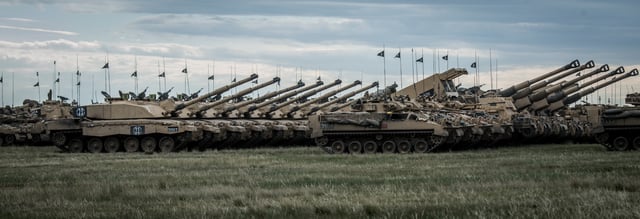
Challenger 2, Warrior, AS90, MLRS and Stormer of the Yorkshire Battlegroup
The forces of the British Army after the Army 2020 reforms are organised in garrison as:
A modified 16 Air Assault Brigade and the 3rd Division will be the Army's primary armoured war-fighting force. Comprising: 1st Armoured Infantry Brigade, 12th Armoured Infantry Brigade, 20th Armoured Infantry Brigade, 1st Artillery Brigade, 101st Logistic Brigade, 25th Engineer Group, 7th Air Defence Group. By 2020, this division will reorganise and consist of two armoured infantry brigades and two strike brigades.[180][181]
The 1st Division, with its blend of lighter infantry, logistics, engineer and medics will provide more strategic choice and a range of capabilities, conducting capacity building, stabilization operations, disaster relief and UK resilience operations. It will include: 4th (Infantry) Brigade, 7th (Infantry) Brigade, 11th (Infantry) Brigade, 51st (Infantry) Brigade, 8th Engineer Brigade, 102nd Logistic Brigade, 104th Logistic Brigade, 2nd Medical Brigade;[180][181]
The 6th (United Kingdom) Division, which will provide forces for asymmetric warfare, intelligence, counter-intelligence, cyber warfare and unconventional fighting will include: 1st Signal Brigade, 11th Signal Brigade, 1st Intelligence Surveillance and Reconnaissance Brigade, 77th Brigade and the Specialist Infantry Group.[182]
For operational tasks the most common unit is the battlegroup, formed around a combat unit and supported by units (or sub-units) from other areas. An example of a battlegroup in the Reactive Force (e.g. the 1st Brigade) would be two companies of armoured infantry (e.g. from the 1st Battalion of the Mercian Regiment), one squadron of heavy armour (e.g. A Squadron of the Royal Tank Regiment), a company of engineers (e.g. B Company of the 22nd Engineer Regiment), a battery of artillery (e.g. D Battery of the 1st Regiment of the Royal Horse Artillery) and smaller attachments from medical, logistic and intelligence units. Typically organised and commanded by a battlegroup headquarters and named after the unit which provided the most combat units, in this example it would be the 1 Mercian Battlegroup). This creates a self-sustaining mixed formation of armour, infantry, artillery, engineers and support units, typically 600 to 1,000 soldiers commanded by a lieutenant colonel.[179]
The table below demonstrates how three or four battlegroups make up a brigade and three or four brigades make up a division. A division is currently the largest unit the British Army is capable of deploying independently, although it could be grouped with three or four other divisions from a multi-national coalition to form a corps.[179]
| Type of unit | Division | Brigade | Battlegroup | Battalion, Regiment | Company,Squadron | Platoon,Troop | Section | Fire Team |
|---|---|---|---|---|---|---|---|---|
| Contains | 3 brigades | 3–4 battalions (battlegroups) | Combined arms unit | 4–6 companies | 3 platoons | 3 sections | 2 fire teams | 4 individuals |
| Personnel | 15,000 | 5,000 | 700–1,000 | 720 | 120 | 30 | 8–10 | 4 |
| Commanded by | Maj-Gen | Brig | Lt Col | Lt Col | Maj | Capt, Ltor2nd Lt | Cpl | LCpl |
Special forces

SAS cap badge
The British Army contributes two of the three special forces formations to the United Kingdom Special Forces directorate: the Special Air Service (SAS) and Special Reconnaissance Regiment (SRR).[183]
The SAS consists of one regular and two reserve regiments.[184] The regular regiment, 22 SAS, has its headquarters at Stirling Lines, Credenhill, Herefordshire. It consists of five squadrons (A, B, D, G and Reserve) and a training wing.[185] 22 SAS is supported by two reserve regiments, 21 SAS and 23 SAS, which collectively form the Special Air Service (Reserve) (SAS [R]), under the command of the 1st Intelligence, Surveillance and Reconnaissance Brigade.[186]
Local units

1939 Dominion and Colonial Regiments

1945 Order of Precedence of the British Army
The British Army historically included many units from what are now separate Commonwealth realms. When the English Empire was established in North America, Bermuda, and the West Indies in the early 17th century there was no standing English Army, only the Militia, and this was extended to the colonies. Colonial militias defended colonies single-handedly at first against indigenous peoples and European competitors. Once the standing English Army, later the British Army, came into existence, the colonial militias fought side-by-side with it in a number of wars, including the Seven Years' War. Some of the colonial militias rebelled during the American War of Independence. Militia fought alongside the regular British Army (and native allies) in defending British North America from their former countrymen during the War of 1812. With the growth of the empire around the world, "non-European" (i.e. non-white, except for officers) units were recruited in many colonies and protectorates, but most were deemed auxiliaries and not part of the British Army. The West India Regiments were an exception, as they were fully incorporated into the British Army, but were kept outside of Europe and non-whites were denied commissions. Locally raised units in strategically-located colonies (including Bermuda, Gibraltar, Malta) and the Channel Islands were generally more fully integrated into the British Army as evident from their appearances in British Army lists, unlike units such as the King's African Rifles. The larger colonies (Australia, New Zealand, Canada, South Africa, etc.) mostly achieved Commonwealth Dominion status before or after the First World War and were granted full legislative independence in 1931. While remaining within the British Empire, this placed their governments on a par with the British government, and hence their military units comprised separate armies (e.g. the Australian Army), although Canada retained the term "militia" for its military forces until the Second World War. From the 1940s, these dominions and many colonies chose full independence, usually becoming Commonwealth realms (as member states of the Commonwealth are known today).[188][189]
Units raised in self-governing and Crown colonies that are part of the British realm remain under British control. The UK retains responsibility for the defence of the fourteen remaining British Overseas Territories, of which four have locally raised regiments:
Recruitment
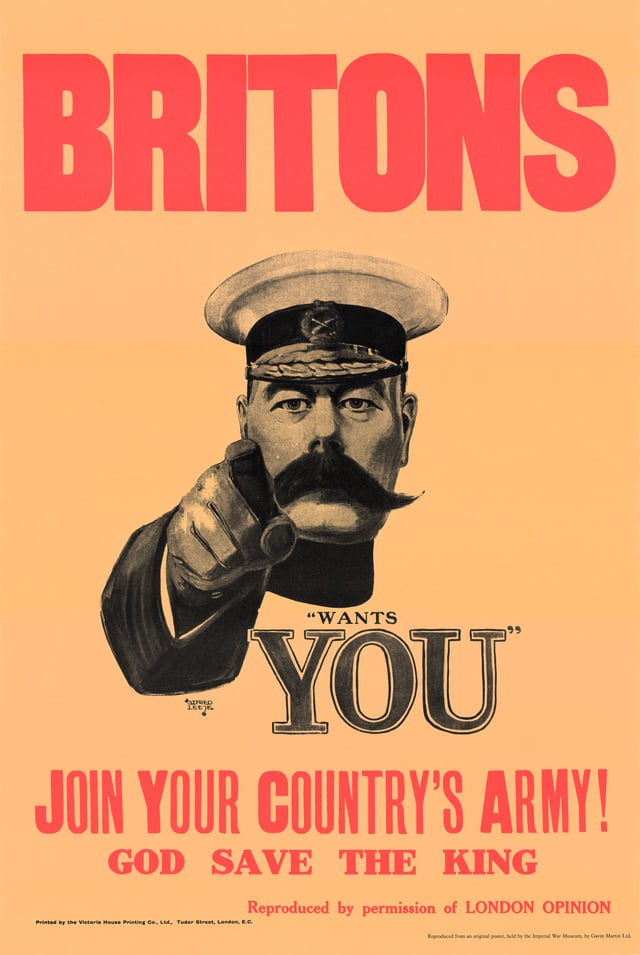
One of the most recognisable recruiting posters of the British Army; from World War I, with Lord Kitchener
Although the army primarily recruits within the United Kingdom, it accepts applications from Commonwealth citizens and (occasionally) those from friendly nations who meet certain criteria. In 2016, it was decided to open all roles to women in 2018; women had not previously been permitted to join the Combat Arms.[194] The British Army is an equal-opportunity employer (with some exceptions due to its medical standards), and does not discriminate based on race, religion or sexual orientation.[195]
The minimum age is 16 (after the end of GCSEs), although soldiers under 18 may not serve in operations.[196] The maximum recruitment age is 35 years and 6 months, and the maximum age for Army Reserve soldiers is 49 years old, as of November 2018. A soldier would traditionally enlist for a term of 22 years, although recently there has been a shift towards 12-year terms with a 22-year option. A soldier is not normally permitted to leave until they have served for at least four years, and must give 12 months' notice.[197]
Oath of allegiance
All soldiers and commissioned officers must take an oath of allegiance upon joining the Army, a process known as attestation.
Those who wish to swear by God use the following words:[14]
I, [soldier's or commissioned officer's name], swear by Almighty God that I will be faithful and bear true allegiance to Her Majesty Queen Elizabeth II, her heirs and successors and that I will as in duty bound honestly and faithfully defend Her Majesty, her heirs and successors in person, crown and dignity against all enemies and will observe and obey all orders of Her Majesty, her heirs and successors and of the generals and officers set over me.[198]
Others replace the words "swear by Almighty God" with "solemnly, sincerely and truly declare and affirm".[14]
Training establishments
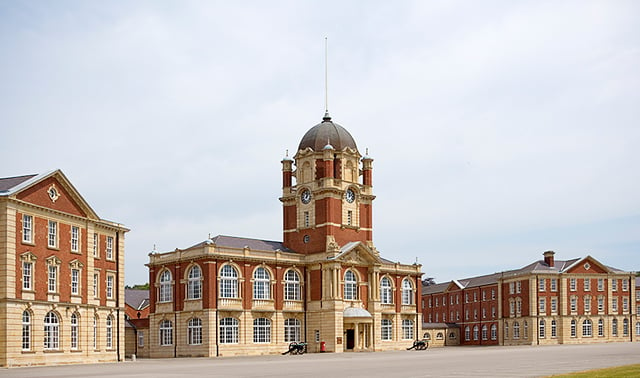
New College buildings at Royal Military Academy Sandhurst
Royal Military Academy Sandhurst (RMAS) is the officer-training school,[199] and Royal School of Artillery (RSA) trains the Royal Artillery.[200] Royal School of Military Engineering (RSME) trains the Corps of Royal Engineers.[201]
The Army Training Regiment, Grantham provides training for Army Reserve recruits,[202] and the Army Training Regiment, Pirbright provides training for the Army Air Corps, the Royal Artillery, the Royal Corps of Signals, the Royal Logistic Corps, the Royal Electrical and Mechanical Engineers, the Adjutant General's Corps, the Royal Army Medical Corps and the Intelligence Corps.[203][204] The Army Training Regiment, Winchester trains the Royal Armoured Corps, the Army Air Corps, the Royal Artillery, the Royal Engineers, the Royal Corps of Signals, the Royal Logistic Corps, the Royal Electrical and Mechanical Engineers, the Adjutant General's Corps, the Royal Army Medical Corps and the Intelligence Corps.[205]
Flags and ensigns
The army's official flag is the 3:5 ratio Union Jack, although a non-ceremonial flag flies at the Ministry of Defence building in Whitehall and is often used at recruiting and military events and exhibitions.[209] It represents the army on the Cenotaph at Whitehall in London, the UK memorial to its war dead.[210] Each British Army unit has a set of flags, known as the colours—normally a Regimental Colour and a Queen's Colour (the Union Jack).
Ranks, specialisms and insignia
- Officers
| NATO code | OF-10 | OF-9 | OF-8 | OF-7 | OF-6 | OF-5 | OF-4 | OF-3 | OF-2 | OF-1 | OF(D) | Student officer | ||||||||||||||||||||||||
|---|---|---|---|---|---|---|---|---|---|---|---|---|---|---|---|---|---|---|---|---|---|---|---|---|---|---|---|---|---|---|---|---|---|---|---|---|
| United Kingdom(Edit) | **** | No equivalent | ||||||||||||||||||||||||||||||||||
| Field Marshal[5] | General | Lieutenant-General | Major-General | Brigadier | Colonel | Lieutenant-Colonel | Major | Captain | Lieutenant | Second Lieutenant | Officer Cadet | |||||||||||||||||||||||||
| Abbreviation: | FM | Gen | Lt Gen | Maj Gen | Brig | Col | Lt Col | Maj | Capt | Lt | 2Lt | OCdt | ||||||||||||||||||||||||
203Rank in abeyance.
- Enlisted
| NATO Code | OR-9 | OR-8 | OR-7 | OR-6 | OR-5 | OR-4 | OR-3 | OR-2 | OR-1 | |||||||||||||||||||||||||||
|---|---|---|---|---|---|---|---|---|---|---|---|---|---|---|---|---|---|---|---|---|---|---|---|---|---|---|---|---|---|---|---|---|---|---|---|---|
| United Kingdom(Edit) | No equivalent | No insignia | ||||||||||||||||||||||||||||||||||
| Warrant officer class 1 | Warrant officer class 2 | Staff/Colour sergeant | Sergeant | Corporal | Lance corporal | Private(or equivalent) | ||||||||||||||||||||||||||||||
| Abbreviation: | WO1 | WO2 | SSgt / CSgt | Sgt | Cpl / Bdr /L/Sgt | LCpl / L/Bdr | Pte | |||||||||||||||||||||||||||||
Each regiment and corps has distinctive insignia, such as a cap badge, beret, tactical recognition flash or stable belt. Many units also call soldiers of different ranks by different names; a NATO OR-1 (private) is called a guardsman in Guards regiments, a gunner in artillery units and a sapper in engineer units. These names do not affect a soldier's pay or role.[211]
Uniforms
The British Army uniform has sixteen categories, ranging from ceremonial uniforms to combat dress to evening wear.
No. 8 Dress, the day-to-day uniform, is known as "Personal Clothing System – Combat Uniform" (PCS-CU)[212] and consists of a Multi-Terrain Pattern (MTP) windproof smock, a lightweight jacket and trousers with ancillary items such as thermals and waterproofs.[213] The army has introduced tactical recognition flashes (TRFs); worn on the right arm of a combat uniform, the insignia denotes the wearer's regiment or corps.[214]
Working headdress is typically a beret, whose colour indicates its wearer's type of regiment. Beret colours are:[215]
Khaki—Foot Guards, Honourable Artillery Company, Princess of Wales's Royal Regiment, Royal Anglian Regiment, Royal Welsh
Light grey—Royal Scots Dragoon Guards, Queen Alexandra's Royal Army Nursing Corps
Brown—King's Royal Hussars
Black—Royal Tank Regiment
Dark (rifle) green—The Rifles, Royal Gurkha Rifles, Small Arms School Corps
Maroon—Parachute Regiment
Beige—Special Air Service
Sky blue—Army Air Corps
Cypress green—Intelligence Corps
Scarlet—Royal Military Police
Green—Adjutant General's Corps
Navy blue—All other units
In addition to working dress, the army has a number of parade uniforms for ceremonial and non-ceremonial occasions.
The most-commonly-seen uniforms are No.1 Dress (full ceremonial, seen at formal occasions such as at the changing of the guard at Buckingham Palace) and No.2 Dress (Service Dress), a brown khaki uniform worn for non-ceremonial parades.[213]
See also
Army Cadet Force (ACF)
British Army order of precedence
British Army uniform
British campaign medals
British military history
Future of the British Army (Army 2020)
Strategic Defence and Security Review 2015
List of British Army installations
List of British Army regiments
Ministry of Defence
Modern equipment of the British Army
Redcoat
Sexual orientation and military service
Army Reserve (United Kingdom)
United Kingdom Special Forces
Tommy Atkins
